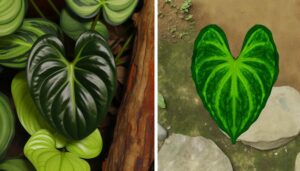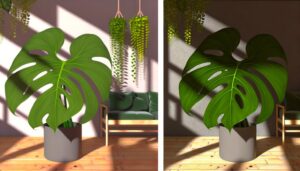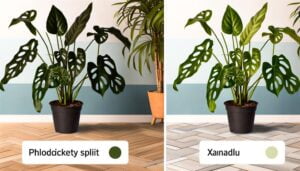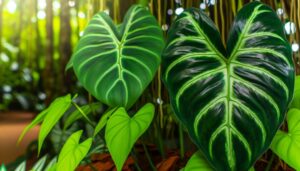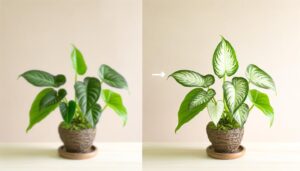Philodendron Cordatum Vs Hederaceum: Which is Better?
Philodendron cordatum and Philodendron hederaceum are distinct species within the Araceae family, both native to Central and South America’s tropical rainforests. Cordatum features smoother, broader, and glossier heart-shaped leaves, contrasting with hederaceum’s velvety, narrower, and elongated foliage.
Cordatum exhibits a more compact, bushy growth habit, whereas hederaceum grows vigorously with longer stems and pronounced internodal spacing. Both plants thrive in bright, indirect light and high humidity, although cordatum needs consistently moist soil, unlike hederaceum, which tolerates intermittent drying.
By understanding these nuances, one can better appreciate each species’ unique attributes and care requirements.
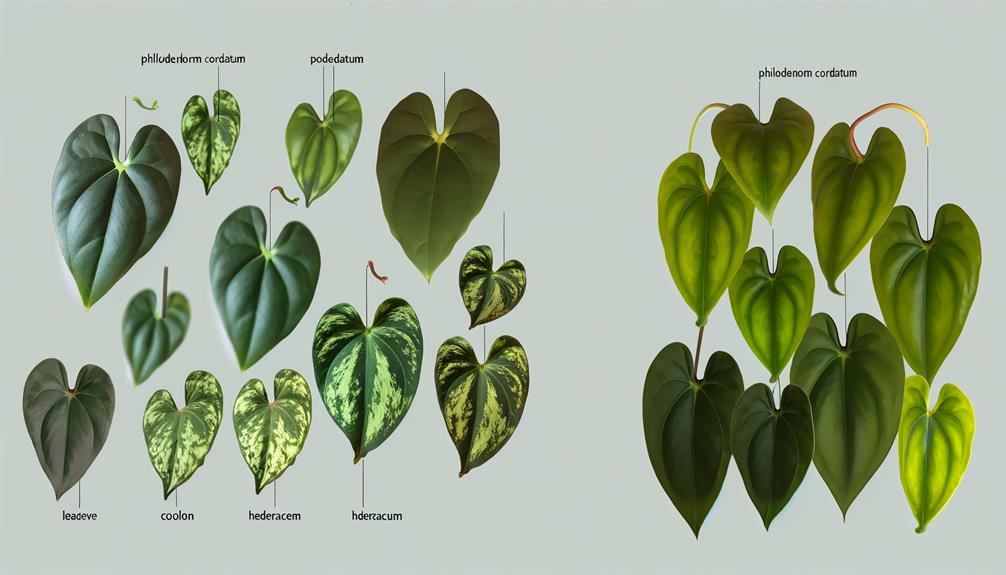
Comparison of Philodendron Cordatum and Philodendron Hederaceum
| Characteristic | Philodendron Cordatum | Philodendron Hederaceum |
|---|---|---|
| Scientific Name | Philodendron hederaceum | Philodendron hederaceum |
| Common Names | Heart Leaf Philodendron, Cordatum | Heartleaf Philodendron, Hederaceum |
| Leaf Shape | Heart-shaped | Heart-shaped |
| Native Region | Central America, Caribbean | Central America, Caribbean |
| Growth Habit | Climbing, vining | Climbing, vining |
| Mature Size | 3-6 m (10-20 ft) | 3-6 m (10-20 ft) |
| Leaf Size | Up to 30 cm (12 in) long | Up to 30 cm (12 in) long |
| Light Preference | Tolerant of low-medium light, prefers bright indirect light | Tolerant of wide range of light conditions |
| Care Difficulty | Easy | Easy |
| Propagation | Easy via cuttings | Easy via cuttings or layering |
Origins and Natural Habitat
Philodendron cordatum and Philodendron hederaceum, both belonging to the Araceae family, originate from the tropical rainforests of Central and South America, where they thrive in the warm, humid understory. These species are adapted to low-light environments, utilizing their epiphytic nature to climb trees and access diffused sunlight.
Philodendrons are often found clinging to tree trunks with their aerial roots, which absorb moisture and nutrients from the humid air and organic debris. Studies indicate that their native habitats maintain temperatures between 20-30°C and high humidity levels, essential for their growth.
Additionally, they play a role in the ecosystem by providing microhabitats for various fauna and contributing to the forest’s nutrient cycling through leaf litter decomposition.
Leaf Shape and Texture
In comparing the leaf shape and texture of Philodendron cordatum and Philodendron hederaceum, both species exhibit heart-shaped leaves, yet subtle morphological differences can be observed.
Philodendron cordatum typically presents smoother, glossier foliage, whereas Philodendron hederaceum often features a more velvety texture.
Additionally, variations in leaf size and growth patterns further distinguish these two species, with hederaceum generally displaying a more robust and expansive growth habit.
Heart-shaped Leaf Comparison
The heart-shaped leaves of Philodendron cordatum and Hederaceum exhibit distinct differences in both shape and texture, necessitating a detailed comparative analysis to elucidate these botanical characteristics.
Philodendron cordatum typically possesses broader leaves with a more pronounced curvature at the base, while Hederaceum leaves are generally narrower and elongated.
- Leaf Apex: Cordatum leaves often have a more acute apex compared to the more rounded tips of Hederaceum.
- Vein Pattern: Cordatum exhibits a more prominent, reticulate vein pattern, enhancing its visual texture.
- Leaf Margin: The margins of Cordatum leaves are smoother and less undulated than those of Hederaceum.
These morphological distinctions are critical for accurate identification and understanding of their respective horticultural applications.
Smooth Vs. Velvety Texture
Beyond the structural differences in leaf shape, the textural variations between Philodendron cordatum and Hederaceum leaves are equally significant. Cordatum leaves exhibit a smooth, glossy surface while Hederaceum leaves often display a velvety, matte texture.
The smooth texture of Philodendron cordatum is a result of its waxy cuticle, which facilitates efficient water retention and deters herbivores. In contrast, Hederaceum’s velvety texture is attributed to minute, hair-like structures known as trichomes, which serve to reduce water loss and protect against excessive sunlight.
These textural differences not only influence the plants’ ecological adaptations but also affect their aesthetic appeal. Each species is uniquely suited to specific environments and decorative preferences.
Size and Growth Patterns
Although both Philodendron cordatum and Hederaceum share similarities in their vining growth habit, their size and growth patterns reveal distinct differences that are essential for horticulturalists and plant enthusiasts to take into account.
Philodendron cordatum typically exhibits smaller, heart-shaped leaves with a smoother texture. Conversely, Philodendron hederaceum grows larger leaves that may develop a more pronounced, velvety texture.
- Leaf Size: Philodendron cordatum leaves are generally smaller, averaging 2-4 inches, while Hederaceum can reach 8-12 inches.
- Growth Rate: Hederaceum tends to grow more rapidly, covering more space in less time.
- Leaf Shape: Cordatum’s leaves are more uniformly heart-shaped, whereas Hederaceum’s leaves can vary more in shape and size.
These distinctions are crucial for optimal care and placement within a botanical collection.
Growth Patterns
Philodendron cordatum and Philodendron hederaceum exhibit distinct growth patterns that are essential for their identification and cultivation.
Philodendron cordatum typically demonstrates a vining habit, producing elongated stems that can climb or trail, supported by aerial roots. This species often displays a more compact and bushy growth when pruned.
Conversely, Philodendron hederaceum also exhibits a vining growth pattern but tends to grow more vigorously, with stems that can extend significantly longer, achieving greater height when given proper support. The internodal spacing in hederaceum is generally more pronounced, enabling faster spread.
Empirical studies suggest that these differential growth dynamics are influenced by genetic variations and environmental interactions, important for optimizing horticultural practices.
Light Requirements
With regards to light needs, Philodendron cordatum and Philodendron hederaceum both thrive in bright, indirect light, though they can tolerate lower light conditions, which may impact their growth rates and foliage coloration.
Ideal light levels promote robust photosynthesis and vibrant leaf pigmentation. Insufficient light exposure can result in etiolation, where stems elongate, and leaves become sparse.
- Bright, indirect light: Encourages vigorous growth and maintains vibrant foliage.
- Low light tolerance: Both species can adapt but may show slower growth and less vivid leaf color.
- Avoid direct sunlight: Direct exposure can lead to leaf scorching and chlorophyll degradation.
Understanding these light requirements helps in creating an optimal indoor environment conducive to the health and aesthetic appeal of these Philodendron species.
Watering Needs
Philodendron cordatum and Philodendron hederaceum exhibit distinct preferences when it comes to soil moisture and watering frequency. Both species thrive in well-draining soil, yet Philodendron cordatum tends to prefer a consistently moist substrate, while Philodendron hederaceum is more tolerant of intermittent drying periods.
Empirical observations suggest that overwatering either species can lead to root rot, necessitating a balanced watering regimen tailored to their specific moisture requirements.
Optimal Soil Moisture
Maintaining ideal soil moisture is necessary for the health of both Philodendron cordatum and Philodendron hederaceum, as improper watering can lead to root rot or dehydration. These species thrive in consistently moist but not waterlogged soil.
Optimal soil conditions can be described with the following characteristics:
- Well-draining properties: A mix containing perlite or orchid bark ensures excess water does not accumulate, preventing root rot.
- Moisture retention: Incorporating organic matter such as peat moss helps retain necessary moisture without becoming overly saturated.
- Aeration: A well-aerated soil structure allows oxygen to reach the roots, crucial for metabolic processes and overall plant health.
Understanding and maintaining these soil moisture parameters are vital for promoting robust growth and longevity in Philodendron species.
Frequency of Watering
Proper soil moisture management naturally leads to the consideration of watering frequency. This must be carefully adjusted to meet the physiological needs of Philodendron cordatum and Philodendron hederaceum.
Both species thrive in evenly moist substrates; however, overwatering can lead to root rot, while underwatering causes leaf desiccation.
Empirical evidence suggests that Philodendron cordatum typically requires watering once the top 1-2 inches of soil are dry, approximately every 7-10 days.
Conversely, Philodendron hederaceum may necessitate slightly more frequent watering, about once every 5-7 days, due to its faster growth rate. Seasonal variations, such as reduced transpiration in winter, necessitate further adjustments.
Consistent monitoring of soil moisture levels is imperative to maintain the best hydration and ensure robust plant health.
Soil Preferences
Ensuring ideal growth for both Philodendron cordatum and Philodendron hederaceum necessitates a well-draining, nutrient-rich soil composition that can retain moisture without becoming waterlogged.
A balanced soil mix, often incorporating organic material, perlite, and peat moss, provides the necessary aeration and drainage. These elements prevent root rot while facilitating nutrient uptake.
- Organic Material: Enhances soil structure and nutrient availability, promoting healthy root development.
- Perlite: Improves aeration and drainage, preventing soil compaction and water retention issues.
- Peat Moss: Retains moisture effectively while maintaining a slightly acidic pH, which is beneficial for philodendrons.
Evidence suggests that these components collectively create an ideal growing medium, ensuring robust plant health and vigor.
Temperature and Humidity
In addition to ideal soil conditions, Philodendron cordatum and Philodendron hederaceum thrive best within specific temperature and humidity ranges that mimic their native tropical environments. Both species flourish at temperatures between 65°F to 80°F (18°C to 27°C) and require high humidity levels, ideally between 60% to 80%.
These conditions facilitate optimum physiological processes, such as photosynthesis and transpiration. Evidence indicates that lower temperatures below 55°F (13°C) can cause growth retardation and leaf damage. Additionally, insufficient humidity might lead to desiccation of foliage, reducing overall plant vigor.
Ensuring stable, warm temperatures and maintaining ample moisture in the air will greatly enhance the health and growth rate of both P. cordatum and P. hederaceum, reflecting their tropical origins.
Common Pests and Diseases
Both Philodendron cordatum and Philodendron hederaceum are prone to a variety of pests and diseases, including spider mites, aphids, mealybugs, and fungal infections such as leaf spot and root rot. These conditions jeopardize plant health by disrupting photosynthesis and nutrient uptake, resulting in chlorosis, wilting, and necrosis.
Effective management involves regular monitoring, early detection, and appropriate interventions.
- Spider mites: Tiny arachnids causing stippled discoloration and webbing on leaves.
- Aphids: Small sap-sucking insects leading to distorted growth and sooty mold.
- Fungal infections: Pathogens causing leaf spot and root rot, often worsened by overwatering or poor air circulation.
Proactive care, including proper watering practices and pest control, is crucial for maintaining plant robustness.
Propagation Techniques
While managing pests and diseases is important for plant health, understanding effective propagation techniques can guarantee the continued growth and expansion of both Philodendron cordatum and Philodendron hederaceum.
Propagation is typically achieved through stem cuttings, allowing for vegetative reproduction that maintains genetic consistency. Both species thrive in a moist, well-aerated medium, such as a mix of perlite and peat moss.
| Technique | Description |
|---|---|
| Water Propagation | Submerge stem cuttings in water until roots develop, then transfer to soil. |
| Soil Propagation | Insert cuttings directly into soil; maintain high humidity until roots establish. |
| Air Layering | Wrap a section of stem with moist sphagnum moss; roots form within weeks. |
These methods promote robust root development, essential for plant vitality.
Conclusion
In the intricate dance of botanical distinctions, Philodendron cordatum and Philodendron hederaceum present a mesmerizing array of both subtle and pronounced differences.
The comparative analysis of their origins, leaf morphology, growth dynamics, and ecological preferences reveals a complex tapestry of plant characteristics.
Yet, the ultimate question remains: which species, with its unique adaptations and care requirements, will thrive most magnificently in a given environment?
The answer lies in understanding and respecting their specific needs and natural proclivities.


